 The eco-fragile Sagarmatha National Park and buffer zone in northeastern Nepal is home to Mount Everest and seven other peaks. The park attracts more than 52,000 trekkers and tourists annually, of which 400 to 500 attempt to summit the world’s tallest peak. The Sherpa community, including the last living member of the first Everest expedition,wants the government to cap the number of climbers allowed per season. Mongabay India correspondent Nidhi Jamwal reports
The eco-fragile Sagarmatha National Park and buffer zone in northeastern Nepal is home to Mount Everest and seven other peaks. The park attracts more than 52,000 trekkers and tourists annually, of which 400 to 500 attempt to summit the world’s tallest peak. The Sherpa community, including the last living member of the first Everest expedition,wants the government to cap the number of climbers allowed per season. Mongabay India correspondent Nidhi Jamwal reports Kancha Sherpa was barely 20 years old when he became a part of the climbing team that accompanied Edmund Hillary and Sherpa Tenzing Norgay, the first people to summit Mount Everest, on May 29, 1953. Today, at 92, Kancha is the last living member of that team.From his home in Namche village in Khumbu Pasang Lhamu Rural Municipality, Kancha watches hordes of mountaineers and trekkers making their way to the world’s tallest peak. The May 1953 expedition he was part of had opened the doors of Mount Everest to the world.
Kancha Sherpa was barely 20 years old when he became a part of the climbing team that accompanied Edmund Hillary and Sherpa Tenzing Norgay, the first people to summit Mount Everest, on May 29, 1953. Today, at 92, Kancha is the last living member of that team.From his home in Namche village in Khumbu Pasang Lhamu Rural Municipality, Kancha watches hordes of mountaineers and trekkers making their way to the world’s tallest peak. The May 1953 expedition he was part of had opened the doors of Mount Everest to the world.
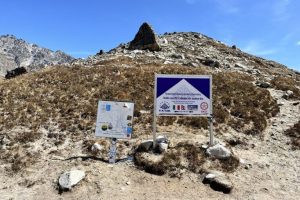 Since then, annually, hundreds of climbers from across the globe crowd into the Solukhumbu district of Nepal to scale Mount Everest, locally known as Sagarmatha. The Sherpas, a Tibetan-origin ethnic community of Nepal, revere Sagarmatha as a goddess and worship her. She is also known as Chomolungma (Qomolangma) in Tibetan, meaning ‘Mother Goddess of the World.’
Since then, annually, hundreds of climbers from across the globe crowd into the Solukhumbu district of Nepal to scale Mount Everest, locally known as Sagarmatha. The Sherpas, a Tibetan-origin ethnic community of Nepal, revere Sagarmatha as a goddess and worship her. She is also known as Chomolungma (Qomolangma) in Tibetan, meaning ‘Mother Goddess of the World.’
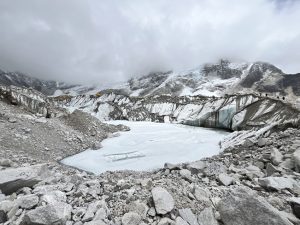 “The number of climbers and travellers is growing by leaps and bounds. Anyone who has money to pay the government can try to summit Sagarmatha. All that the government wants is money,” worries Kancha.
“The number of climbers and travellers is growing by leaps and bounds. Anyone who has money to pay the government can try to summit Sagarmatha. All that the government wants is money,” worries Kancha.
“For the Sherpas, Sagarmatha is our Devi; she is our Provider. We set our foot on Her only after seeking her forgiveness first,” he tells Mongabay India.
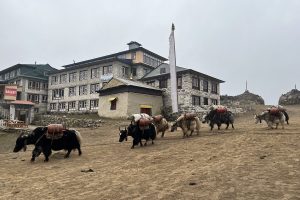 Nepal is home to eight of the world’s ten highest peaks, and foreign climbers are a major source of revenue for the Himalayan nation. In 2023, the government earned around $5 million in revenue from Mount Everest alone in one climbing season. There is no cap on the number of permits issued by the government to summit the various peaks.
Nepal is home to eight of the world’s ten highest peaks, and foreign climbers are a major source of revenue for the Himalayan nation. In 2023, the government earned around $5 million in revenue from Mount Everest alone in one climbing season. There is no cap on the number of permits issued by the government to summit the various peaks.
A surge of summit seekers
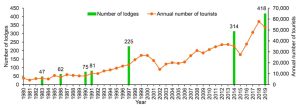 Social media was recently abuzz with visuals of a serpentine traffic jam-like situation in which climbers, in their trekking suits and mountaineering boots, jostled to reach the ‘top of the world.’ The video clips show a long line of climbers perched precariously on a narrow strip of ice, waiting to move upward as those who completed the summit try to descend.
Social media was recently abuzz with visuals of a serpentine traffic jam-like situation in which climbers, in their trekking suits and mountaineering boots, jostled to reach the ‘top of the world.’ The video clips show a long line of climbers perched precariously on a narrow strip of ice, waiting to move upward as those who completed the summit try to descend.
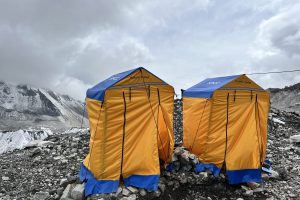 Delays due to overcrowding expose climbers to long periods of harsh conditions, which depletes their oxygen levels and increases their risk of sickness and exhaustion, sometimes leading to death.
Delays due to overcrowding expose climbers to long periods of harsh conditions, which depletes their oxygen levels and increases their risk of sickness and exhaustion, sometimes leading to death.
Trekkers are increasing in the eco-fragile Khumbu region, where Everest and seven other peaks are located inside the Sagarmatha National Park and Buffer Zone, a UNESCO World Heritage Site spread across 1,148 square kilometres. The high-altitude region is home to a number of glaciers and glacial lakes, including the world’s highest glacier Khumbu, which is more than 15 kilometres long.
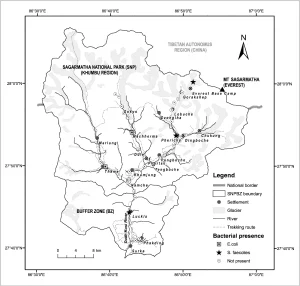 More than 52,000 trekkers and climbers annually visit this national park. Of these, some 400 to 450 climbers attempt to summit Everest every year.
More than 52,000 trekkers and climbers annually visit this national park. Of these, some 400 to 450 climbers attempt to summit Everest every year.
The tourism department charges $11,000 per foreign climber as a permit fee (spring season, April to June) to summit Everest. There is a proposal to increase the fee to$15,000 from next year. Nepali citizens pay around $562 (at the current conversion rate of NPR 133.45 per U.S. dollar) per permit. The permit fee varies for different peaks with Mount Everest attracting the highest fee.
Last spring season (2023), the government issued 454 permits to climb Mount Everest; and 17 deaths were reported. In 2024, it issued 403 permits for Everest; at least eight deaths have already been reported.
An August 2020 paper in PLoS ONE, a journal, has documented how the number of climbers of Mount Everest are increasing and their success rate has more than doubled. Between 2010 and 2019, two-thirds of first-time Everest climbers reached the summit, up from less than one-third in the 1990s. Crowding near the summit has increased steeply too in recent years.
While the government is yet to take a decision on capping the number of climbers, Nepal’s Supreme Court has stepped in. In April, it directed the government to limit the number of expedition permits to Everest and other peaks based on their carrying capacities.
Rising temperatures, melting glaciers
Everest region, also known as Khumbu, which is the Nepal side of Mount Everest, is already facing the brunt of climate change as temperatures rise, glaciers melt faster, and the risk of glacial lake outburst floods (GLOF) increases. The increase in garbage generation, including plastics and human waste, is also raising a stink.
Kancha is worried. He can’t forget what his father had told him as a child: that the goddess Miyolangsangma lived at the top of Sagarmatha.
In a remote corner of Lobuche in the Everest region, at 5050 metres above mean sea level, a gleaming three-storey building houses the world’s highest research stations. Pyramid International Laboratory-Observatory is a joint Italian-Nepalese facility that was opened in 1990 to collect data and conduct scientific research in the high-altitude region.
Although the laboratory hasn’t been fully functional for the past decade due to a lack of funds, Ines Dussaillant, a glaciologist, regularly visits it for her research activities. She is from Chile but now works with the World Glacier Monitoring Service at the University of Zurich in Switzerland.
“I come here every year to know how glaciers in this region are evolving,” Dussaillant told Mongabay-India when she visited Pyramid Lab on May 8.
She described the glaciers as sentinels of climate change and they are studied to understand climate change. “We first measure the accumulation of snow and then the melt of snow throughout the hydrological year. The balance between the two tells us the health of a glacier,” the glaciologist explained.
Dussaillant has been involved in monitoring the Mera glacier in the Everest region.
According to her, in the past two years, there has not been an accumulation of snow on top of Mera Peak at 6476 metres elevation. Mera glacier is one of the reference glaciers, she said, and it can be extrapolated to understand what is happening to surrounding glaciers in the region.
“That means glaciers are not getting fed there and are just losing ice. This measurement [of Mera glacier since 2007] tells us that the melting of glaciers has been accelerating in recent years. If we don’t get accumulation in the next few years in the upper reaches, glaciers will probably disappear faster than expected,” she warned.
Glaciers at the roof of the world are in danger and increasing human activity (climbers, trekkers, porters, guides, etc) in the region is only adding to the problem.
Khumbu glacier, where the Everest Base Camp is situated, is also thinning and sinking. This has prompted a discussion on the need to relocate the base camp 200 metre to 400 metre lower.
An August 2017 study by researchers at the University of Leeds and University of Arizona has estimated that 197,649,227 cubic metres of ice melted over the period 1984–2015 on the Khumbu glacier in response to a warming climate.
It also warned that “rockfall activity is likely to increase in the high-mountain environment as snow and ice melts from mountain slopes, requiring changes to climbing routes on the world’s highest peaks. Similarly, route difficulty will be affected by changing monsoon precipitation patterns, which determines windows of opportunity for ascents and the distribution and quantity of snowfall.”
Dussaillant explains that when glaciers retreat, they leave a very unstable terrain. And if a lake is created, it is dammed by unstable moraine, which can be very risky for regions like the Himalayas where a large number of people live in villages downstream of these glacial lakes.
“Himalayas are a hotspot as glaciers are retreating very fast, leading to the creation of these lakes, which can breach and destroy villages. Some system needs to be developed to drain these lakes and also create an early warning system,” she said.
The cost of climbing
Lama Kazi Sherpa lives in Namche village, not too far from Kancha Sherpa’s home, and plays a role in the management of Khumbu region. Members of the indigenous community manage the eco fragile zone of Sagarmatha National Park and buffer zone, along with support from the forest department and other government agencies.
Lama Kazi is the president of the Sagarmatha Pollution Control Committee and also the chairperson of the buffer zone council. The Pollution Control Committee is a community-based NGO established in 1991 by the local Sherpa people. Lama Kazi has been associated with it for the past 12 years. Management of waste is one of the key responsibilities of this committee.
“About 20-25 years back, this area was not very busy, and there weren’t too many lodges and hotels. But the interest of trekkers and tourists has been growing, and so has the waste generation,” says Lama Kazi.
The Sagarmatha Pollution Control Committee has installed large-sized dustbins for waste collection, but the region lacks a proper waste processing and disposal system. Non-biodegradable waste is either burnt or sent to Lukla/Kathmandu. Biodegradable waste is used by local villages in their farmlands, where local millet varieties and some vegetables are cultivated in the spring season.
Sagarmatha Next, a novel centre located at Syangboche (near Namche Bazar), is trying to address the waste problem in Everest region through recycling, upcycling and converting trash into design and art products. It is also helping set up material recovery facilities along the trekking path from Lukla to Everest Base Camp. But the waste problem at hand is humungous.
A 2010 study reported that during the tourist season (April-May and October-November), 4.6 tonnes per day of waste is generated in Sagarmatha National Park and the buffer zone.
Lama Kazi did not have year-wise waste generation data to share but admitted that it is rising. “During the climbing season, Namche alone generates 70,000 kilograms of waste. From Mount Everest, we collect over 30,000 kilograms of waste in 70 days,” he says. The Khumbu region has no wastewater or sewage treatment plant.
Tshering Sherpa is the son of Kancha Sherpa. He closely works with Lama Kazi on waste management in the region. “Through climbing permits, the government collects money and gives a part of it to the three user committees of local villagers to manage the waste. Last fiscal year, a user committee had to receive NPR 56 lakh ($41,962) but got only NPR 19 lakh ($14,237) due to economic issues in the country,” he says.
Like his father Kancha, Tshering is also concerned about the overcrowding on Mount Everest. “There should be a limit on the number of climbers allowed per season. We cannot look at tourist numbers alone. We have to think and plan how to manage Namche and other Sherpa villages in the region that lack both waste and wastewater management systems,” he says.
Lama Kazi, too, believes that there should be a cap on the number of climbers to Sagarmatha. “For us, she is much more than a mountain. She is our goddess, and we worship her. Right now, there is some sort of competition to scale the world’s tallest peak. We do not know what really happens up there. Government must regulate and monitor activities there,” he said, clarifying that this was his personal opinion and not that of the Sagarmatha Pollution Control Committee.
According to him, Khumbu is already facing several challenges due to climate change. “We are receiving less snowfall. The timing of heavy snowfall has also shifted from January and February to March, April, and May. We are also seeing mosquitoes here, which was never the case earlier,” he trails off.
(Reporting for this story has been part of the Himalayan Climate Boot Camp 2024 organised by Nepal Forum of Science Journalists)
Mongabay India/TWF
Photo credits and captions: 1: Khumbu glacier at Everest Base Camp, with the makeshift tent toilets (yellow) visible on the top left. Image by Nidhi Jamwal.
2. When he was 20, Kancha Sherpa had joined Edmund Hillary and Tenzing Norgay’s historic Everest summit team in 1953. Image by Nidhi Jamwal.
3. Mount Everest. Image by Nidhi Jamwal.
4. A signboard pointing towards Pyramid International Laboratory-Observatory, a joint Italian-Nepalese facility opened in 1990 for high-altitude scientific research. Image by Nidhi Jamwal.
5. A glacier in Khumbu region. Rising temperatures accelerate glacier melt, increasing the risk of glacial lake outburst floods. Image by Nidhi Jamwal.
6. Yaks carrying essential supplies in the tough terrain of the hills, a lifeline for the remote communities in the Everest region. Image by Nidhi Jamwal.
7. Number of lodges and tourists visiting Sagarmatha National Park and Buffer Zone. Graph from Yujie Sun et al. (2021). Tourism-Related Facility Development in Sagarmatha (Mount Everest) National Park and Buffer Zone, Nepal Himalaya.
8. Makeshift tent toilets at Everest Base Camp during climbing season. Photo by Nidhi Jamwal.



